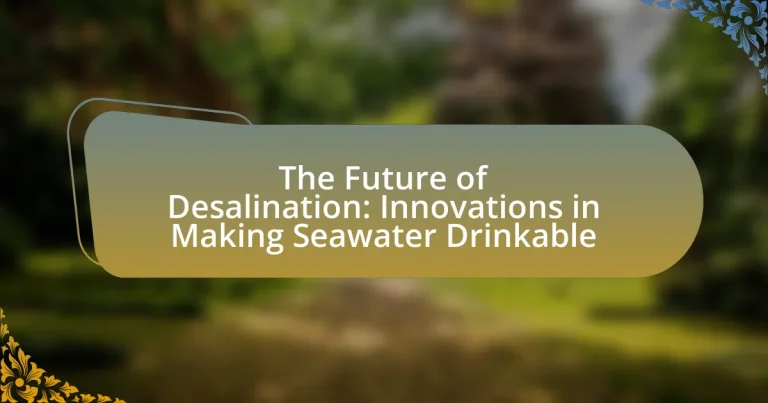The main entity of the article is desalination, a technology that converts seawater into potable water. The article explores the future of desalination, highlighting advancements in technology that improve efficiency and reduce costs, such as energy-efficient reverse osmosis membranes and the integration of renewable energy sources. It discusses key desalination processes, compares different methods, and addresses the importance of desalination in combating global water scarcity. Additionally, the article examines innovations shaping the industry, environmental impacts, and the economic barriers to widespread adoption, while outlining best practices for successful desalination projects.

What is the Future of Desalination?
The future of desalination is characterized by advancements in technology that enhance efficiency and reduce costs. Innovations such as reverse osmosis membranes with improved permeability and energy recovery systems are expected to significantly lower energy consumption, which currently accounts for a large portion of desalination costs. For instance, the International Desalination Association reports that energy-efficient technologies could reduce energy use by up to 30%. Additionally, the integration of renewable energy sources, such as solar and wind, into desalination processes is anticipated to further decrease operational costs and environmental impact. These developments indicate a promising trajectory for desalination as a sustainable solution to global water scarcity.
How does desalination technology work?
Desalination technology works by removing salt and other impurities from seawater to produce fresh water. This process typically involves methods such as reverse osmosis and distillation. In reverse osmosis, seawater is forced through a semi-permeable membrane that allows water molecules to pass while blocking salt and other contaminants. Distillation, on the other hand, involves heating seawater to create steam, which is then condensed back into liquid form, leaving salts behind. According to the International Desalination Association, as of 2020, there are over 20,000 desalination plants worldwide, producing more than 95 million cubic meters of fresh water daily, demonstrating the technology’s effectiveness in addressing water scarcity.
What are the key processes involved in desalination?
The key processes involved in desalination are reverse osmosis, distillation, and electrodialysis. Reverse osmosis utilizes a semi-permeable membrane to separate salt and impurities from water, allowing only fresh water to pass through. Distillation involves heating seawater to create steam, which is then condensed back into liquid form, leaving salts behind. Electrodialysis employs an electric field to drive ions through selective ion-exchange membranes, effectively separating salt from water. These processes are essential for converting seawater into potable water, addressing global water scarcity challenges.
How do different desalination methods compare?
Different desalination methods, such as reverse osmosis, thermal distillation, and electrodialysis, vary significantly in efficiency, cost, and environmental impact. Reverse osmosis is the most widely used method, known for its energy efficiency and lower operational costs, typically requiring 3-5 kWh per cubic meter of water produced. Thermal distillation, while effective, is generally more energy-intensive, consuming around 10-15 kWh per cubic meter, making it less economically viable in regions with high energy costs. Electrodialysis, which uses electric currents to drive ion exchange, is suitable for brackish water and has lower energy requirements than thermal methods but is less effective for seawater desalination. These differences highlight the importance of selecting the appropriate desalination technology based on specific regional needs and resource availability.
Why is desalination important for the future?
Desalination is important for the future because it provides a sustainable solution to the growing global water scarcity crisis. As populations increase and climate change exacerbates drought conditions, traditional freshwater sources are becoming increasingly unreliable. According to the United Nations, by 2025, two-thirds of the world’s population may face water-stressed conditions, making desalination a critical technology for ensuring access to clean drinking water. Furthermore, advancements in desalination technologies, such as reverse osmosis and solar desalination, are making the process more energy-efficient and cost-effective, thereby enhancing its viability as a long-term water supply solution.
What global challenges does desalination address?
Desalination addresses global challenges such as freshwater scarcity, population growth, and climate change. Freshwater scarcity affects over 2 billion people worldwide, making access to clean water a critical issue. As the global population is projected to reach nearly 10 billion by 2050, the demand for freshwater resources will increase significantly. Additionally, climate change exacerbates water shortages through altered precipitation patterns and increased evaporation rates. Desalination provides a viable solution by converting seawater into potable water, thereby supplementing existing freshwater supplies and enhancing water security in arid regions.
How does desalination contribute to water security?
Desalination significantly enhances water security by providing a reliable source of freshwater from seawater, which is crucial in arid regions and areas facing water scarcity. This technology can produce millions of cubic meters of potable water daily; for instance, the Sorek desalination plant in Israel generates approximately 624,000 cubic meters of water per day, supplying about 20% of the country’s drinking water. By diversifying water supply sources, desalination reduces dependence on traditional freshwater sources, such as rivers and aquifers, which are often over-exploited or contaminated. This capability is vital for ensuring a stable and sustainable water supply, particularly in the face of climate change and increasing population demands.

What innovations are shaping the future of desalination?
Innovations shaping the future of desalination include advanced membrane technologies, solar desalination, and energy-efficient processes. Advanced membrane technologies, such as graphene oxide membranes, significantly enhance water permeability and salt rejection, leading to lower energy consumption. Solar desalination utilizes solar energy to power the desalination process, making it more sustainable and cost-effective. Additionally, energy-efficient processes like reverse osmosis are being optimized with new materials and designs, reducing operational costs and environmental impact. These innovations collectively aim to improve the efficiency and sustainability of desalination, addressing global water scarcity challenges.
How are advancements in technology improving desalination?
Advancements in technology are significantly improving desalination by enhancing efficiency, reducing costs, and increasing water quality. Innovations such as reverse osmosis membranes with higher permeability and lower fouling rates allow for more effective separation of salt from seawater, leading to lower energy consumption. For instance, the development of graphene oxide membranes has shown the potential to reduce energy use by up to 50% compared to traditional methods. Additionally, the integration of renewable energy sources, such as solar and wind, into desalination processes further decreases operational costs and environmental impact. These technological improvements are crucial as they enable the production of potable water at a scale that meets growing global demand, particularly in arid regions.
What role do nanotechnology and membranes play in desalination?
Nanotechnology and membranes are crucial in enhancing the efficiency and effectiveness of desalination processes. Nanotechnology enables the development of advanced membrane materials that possess superior permeability and selectivity, allowing for the more efficient removal of salts and impurities from seawater. For instance, nanostructured membranes can achieve higher water flux rates while maintaining low energy consumption, significantly improving the overall desalination process. Research indicates that membranes incorporating nanomaterials, such as graphene oxide or carbon nanotubes, can outperform traditional membranes by providing better resistance to fouling and degradation, thus extending their operational lifespan and reducing maintenance costs.
How is renewable energy being integrated into desalination processes?
Renewable energy is being integrated into desalination processes primarily through the use of solar, wind, and geothermal energy to power desalination plants. For instance, solar energy is harnessed via photovoltaic panels or concentrated solar power systems to provide the necessary electricity for reverse osmosis desalination, significantly reducing reliance on fossil fuels. A notable example is the 2019 project in Saudi Arabia, where a solar-powered desalination plant was developed, demonstrating the feasibility of using renewable sources for large-scale water production. Additionally, wind energy is utilized in coastal desalination facilities, where wind turbines generate electricity to operate the desalination systems. This integration not only enhances sustainability but also lowers operational costs, as renewable energy sources often have lower long-term expenses compared to traditional energy sources.
What are the environmental impacts of new desalination technologies?
New desalination technologies can have significant environmental impacts, including marine ecosystem disruption, energy consumption, and brine disposal issues. The intake of seawater can harm aquatic life, particularly through the entrainment and impingement of organisms. Additionally, these technologies often require substantial energy, contributing to greenhouse gas emissions if fossil fuels are used. The disposal of concentrated brine back into the ocean can lead to increased salinity and negatively affect local marine habitats. Studies indicate that the environmental footprint of desalination varies based on technology and location, highlighting the need for sustainable practices in implementation.
How do innovations minimize energy consumption in desalination?
Innovations minimize energy consumption in desalination primarily through the development of advanced technologies such as reverse osmosis, energy recovery devices, and solar desalination methods. Reverse osmosis utilizes semi-permeable membranes that require significantly less energy compared to traditional thermal desalination processes, reducing energy consumption by up to 80%. Energy recovery devices, such as pressure exchangers, capture and reuse energy from the high-pressure brine stream, further enhancing efficiency. Additionally, solar desalination leverages renewable energy, decreasing reliance on fossil fuels and lowering overall energy costs. These innovations collectively contribute to more sustainable and efficient desalination practices.
What measures are being taken to reduce brine disposal issues?
Measures being taken to reduce brine disposal issues include the development of advanced brine management technologies and the implementation of zero-liquid discharge systems. These technologies aim to minimize the environmental impact of brine by either reusing it in industrial processes or converting it into valuable byproducts, such as salt and minerals. For instance, research has shown that integrating solar evaporation ponds can effectively concentrate brine, allowing for the extraction of useful materials while reducing the volume of waste. Additionally, regulatory frameworks are being established to ensure that brine disposal methods comply with environmental standards, further mitigating potential harm to marine ecosystems.

What are the future trends in desalination?
Future trends in desalination include advancements in energy efficiency, the integration of renewable energy sources, and the development of innovative membrane technologies. Energy-efficient processes, such as reverse osmosis, are being optimized to reduce energy consumption, with some systems achieving energy recovery rates of over 90%. The use of renewable energy, particularly solar and wind, is being explored to power desalination plants, which can significantly lower operational costs and carbon footprints. Additionally, new membrane materials, such as graphene and biomimetic membranes, are being researched to enhance salt rejection and water permeability, potentially increasing the overall efficiency of desalination processes. These trends are supported by ongoing research and pilot projects demonstrating their feasibility and effectiveness in real-world applications.
How is the market for desalination expected to evolve?
The market for desalination is expected to grow significantly, driven by increasing water scarcity and technological advancements. According to a report by Fortune Business Insights, the global desalination market was valued at approximately $18.3 billion in 2020 and is projected to reach around $36.5 billion by 2028, growing at a compound annual growth rate (CAGR) of 9.1%. This growth is fueled by rising demand for fresh water in arid regions, coupled with innovations in desalination technologies such as reverse osmosis and solar desalination, which enhance efficiency and reduce costs.
What regions are likely to see the most growth in desalination projects?
The regions likely to see the most growth in desalination projects are the Middle East, North Africa, and parts of South Asia. These areas face significant water scarcity due to arid climates and increasing populations. For instance, the Middle East has invested heavily in desalination, with countries like Saudi Arabia and the United Arab Emirates leading the way, as they rely on desalinated water for over 90% of their drinking water supply. Additionally, North Africa is experiencing similar trends, with countries like Algeria and Egypt expanding their desalination capacities to address water shortages exacerbated by climate change.
How are public policies influencing the future of desalination?
Public policies are significantly shaping the future of desalination by providing regulatory frameworks, funding, and incentives that promote technological advancements and infrastructure development. For instance, governments are increasingly implementing policies that prioritize water security and sustainability, which directly encourages investment in desalination technologies. According to the International Desalination Association, as of 2021, over 300 million people rely on desalinated water, and supportive policies are crucial for expanding this capacity to meet growing global water demands. Furthermore, policies that address environmental concerns, such as the impact of brine disposal, are driving innovations in eco-friendly desalination methods, ensuring that future projects align with sustainability goals.
What challenges remain for the future of desalination?
The challenges that remain for the future of desalination include high energy consumption, environmental impact, and cost-effectiveness. High energy consumption is a significant barrier, as current desalination technologies, such as reverse osmosis, require substantial electricity, which can limit their sustainability. Environmental impact arises from the discharge of concentrated brine back into the ocean, which can harm marine ecosystems. Additionally, the cost-effectiveness of desalination remains a concern; while advancements have been made, the overall expense of building and operating desalination plants can be prohibitive, especially in regions with limited financial resources. These challenges must be addressed to enhance the viability and adoption of desalination as a reliable water source.
What are the economic barriers to widespread desalination adoption?
The economic barriers to widespread desalination adoption include high capital costs, operational expenses, and energy requirements. Desalination plants typically require significant initial investment, often exceeding $1 billion, which can deter governments and private investors. Additionally, the ongoing costs of energy, which can account for up to 50% of operational expenses, make desalinated water more expensive than traditional sources. For instance, the cost of desalinated water can range from $0.50 to $3.00 per cubic meter, compared to $0.10 to $0.50 for conventional freshwater sources. These financial challenges hinder the scalability and attractiveness of desalination as a viable solution for water scarcity.
How can public perception of desalination be improved?
Public perception of desalination can be improved through transparent communication and community engagement. By providing clear information about the technology, its benefits, and addressing environmental concerns, stakeholders can build trust. For instance, studies show that communities involved in the decision-making process regarding desalination projects are more likely to support them, as seen in the case of the Carlsbad Desalination Plant in California, where public forums increased local acceptance. Additionally, showcasing successful desalination projects that have positively impacted water scarcity can further enhance public confidence in the technology.
What practical steps can be taken to enhance desalination efforts?
To enhance desalination efforts, implementing advanced technologies such as reverse osmosis and solar desalination is essential. Reverse osmosis utilizes semi-permeable membranes to separate salt from seawater, significantly improving efficiency and reducing energy consumption. For instance, the International Desalination Association reported that reverse osmosis accounts for over 60% of global desalination capacity due to its effectiveness and lower operational costs compared to thermal methods. Additionally, integrating renewable energy sources, like solar and wind, can further reduce the carbon footprint and operational costs of desalination plants. Research from the National Renewable Energy Laboratory indicates that solar desalination can lower energy costs by up to 50%, making it a viable option for sustainable water supply. Furthermore, enhancing water recovery rates through innovative membrane technologies can increase the overall efficiency of desalination processes, allowing for more freshwater production from the same volume of seawater.
How can communities effectively implement desalination solutions?
Communities can effectively implement desalination solutions by conducting thorough feasibility studies to assess local water needs and resource availability. These studies should evaluate the economic, environmental, and social impacts of desalination projects, ensuring that they align with community goals. For instance, the International Desalination Association reports that successful projects often involve stakeholder engagement, which fosters public support and addresses concerns about costs and environmental effects. Additionally, communities should explore innovative technologies, such as reverse osmosis and solar desalination, which have been shown to reduce energy consumption and operational costs. By leveraging government incentives and partnerships with private entities, communities can secure funding and technical expertise, enhancing the viability of desalination initiatives.
What best practices should be followed in desalination projects?
Best practices in desalination projects include conducting thorough feasibility studies, implementing energy-efficient technologies, and ensuring environmental sustainability. Feasibility studies assess the economic, technical, and social viability of the project, which is crucial for informed decision-making. Energy-efficient technologies, such as reverse osmosis and solar desalination, reduce operational costs and environmental impact. Additionally, environmental sustainability practices, like minimizing brine discharge and protecting marine ecosystems, are essential to mitigate negative effects on local habitats. These practices are supported by successful case studies, such as the Sorek desalination plant in Israel, which utilizes advanced technologies and has significantly reduced energy consumption while providing a reliable water supply.


